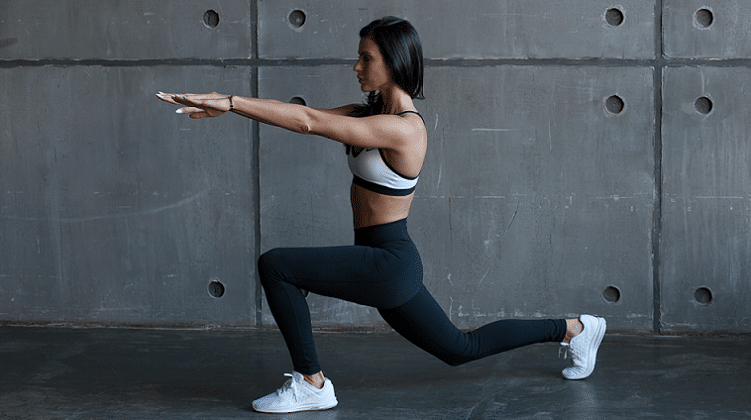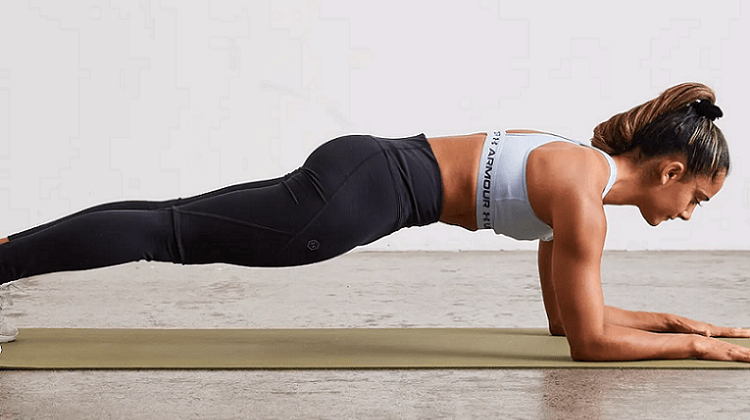Every woman should find time to regularly workout and stay in shape. Apart from improving your fitness levels, a proper workout also provides many other physical, mental and psychological health benefits. This post highlights some bodyweight exercises for women that you can try out today. But first, it is important for you to warmup before any planned bodyweight workout routine.
Warm Up Before You Begin And Cool Down After The Workout
A thorough warmup is essential if you hope to achieve optimal performance during your training sessions. A good warmup will slowly increase your core temperature and the flow of oxygenated blood to your skeletal muscles.
With your heart rate up and your muscles ready to go, you will be able to face the challenges that come with engaging in an intense workout regimen.
These workout challenges often include muscle fatigue and the risk of injury, both of which will be greatly reduced when you spend time on a good warmup beforehand.
Also, by taking some time off to relax and catch your breath after a strenous workout, you can help your body to recover quickly.
Endurance athletes, such as marathon runners, may benefit the most from a proper cooling down period because of the positive effect it has on the heart, blood vessels, and blood pressure.
It is therefore recommended that you incorporate a warmup routine before the commencement of your scheduled workout session and a cooldown period afterwards.

How Do You Warm Up?
As mentioned already, you should warmup just before you start your regular workout. It is always advisable to start with warming up your bigger muscles, like your hamstrings, for example. Once you have properly warmed up your bigger muscle groups, you can then move on to activity or sport specific warmup drills.
A dynamic warmup basically mimics the workout(s) you intend engaging in during your training program, but in a less intense manner. Your warmups should therefore be in-line with your workout, but done at a slower pace in comparison to your actual training session.
Typically, your warmup should be done at varying speeds, usually from a low to a high speed. The whole idea is to get your muscles ready in preparation for the expected intensity of your upcoming training regimen.
Sweating during your warmup is normal and should be encouraged. However, do not forget to hydrate with clean drinking water at all times.
You should also note that when you warmup before your main workout routine, you build stamina and endurance by increasing the flow of oxygenated blood to your muscles. This greatly slows down the build up of lactic acid in your muscles which is primarily responsible for muscle fatigue during weight training.
Apart from a dynamic warmup, there are also many other ways to warmup and the most popular warmup activities include:
- Static stretching: This can be done before and after a workout session. You basically stretch out various muscle groups while maintaining a still posture. Static stretching is useful for improving flexibility and your range of motion. The most common Static stretching warmups include; lying hamstring stretch, hip flexor stretch, and triceps stretch.
- Squats: This is a versatile warmup that aims to target as many lower body muscle groups as possible, such as; your glutes, hamstrings, and quads.
- Planks: If you want a warmup that focuses on improving your posture, balance, back and core strength, then plank is what you need.
- Side lunges: The side lunges warmup helps to strengthen your hips, glutes and legs in preparation for an intense lower body workout session.
- Pushups: You can warmup your glutes, core and upper body with classic pushups.
- Triceps warmup: You need to warmup your triceps, especially if you intend lifting weights. With a triceps warmup, you will increase blood flow to your triceps muscles while improving mobility and flexibility.
Remember that your warmup precedes a workout session, but don’t forget to cooldown afterwards by drastically lowering your level of intensity. This will help to regulate your breathing by bringing it down close to normal while also lowering your heart rate and blood pressure.
Tone Up Your Legs And Glutes With Lunges
Lunges are a great workout routine to help you tone your lower body muscle groups including your thighs, hips, and glutes.
While lunges come in a variety of forms, they all involve extending one leg behind you even as you bring your other leg forward with a bent knee.
However, it is important to always proceed with caution when stretching your leg muscles during lunges.
What makes lunges a truly special exercise is that they can be done anywhere without any special equipment. All you need is some space and an exercise mat if you want.
You should therefore make it a goal of yours to perform a variety of lunges twice to four times per week. The reason why you should not perform lunges on a daily basis is because you need to allow your lower body including your glutes, hips, and legs some time off to recover (usually between 24 to 48 hours) between your workouts.
Standard Lunge
It is very important that you maintain proper form while performing a basic lunge. Here’s what you need to note when executing this exercise.
- Step #1: Keep your hands on your hips and your body erect by standing with your feet together.
- Step #2: Put one foot in front of the other at a 90-degree angle, and then place your toes flat on the ground. Your foot should be flat on the floor as well, and your shin and thigh should be parallel.
- Step #3: Additionally, bring the knee of your other leg down to the floor. Your toes should remain on the ground even as your foot stretches out.
- Step #4: You should now reverse the motion from Step #2 and bring your front leg back to its starting position.

What to do and what not to do during lunges
- Check the alignment of your knees and feet.
- Do not slouch.
Lunges are a great way to strengthen your glures and legs, and many people do them as a warmup (as highlighted earlier) before an intense lower body workout regimen.
There are a variety of lunges to choose from with slightly different methods of execution. Nevertheless, each variant offers distinct advantages.
Weighted Lunges
While a standard lunge form should be mastered first, you can always challenge yourself by lifting weights during a lunge exercise. You can do a standard lunge while holding a kettlebell to your chest, or you can do a curtsy lunge while holding dumbbells. Adding weight to your feet as you lunge will not only strengthen your core and legs, but also your arms, depending on how much weight you use.
Side Lunges
To execute this lunge variant, you first need to lunge forward with your right foot. As soon as you are down in a full lunge, twist your upper body to the right, hold for a few seconds, and then twist back to the center before bringing your right leg back up. You should complete the exercise by switching sides and working your left side.
You can strengthen your core and your lower body by doing side lunges, and you will notice a marked improvement in your balance.
Curtsy Lunges
People who want to strengthen their glutes through exercise can benefit from doing curtsy lunges. Keep your hands on your hips and your body erect by standing with your feet together. Back up until your right foot is behind your left one, then spin it around in a clockwise arc. Make a fist at your chest, and then lunge forward with your left foot. Return to the “curtsy” position, and repeat on the other side.
Work On Your Legs, Back, And Core With Squats
When it comes to building muscle, few exercises are as crucial as the squat. Whether you are doing lower-body or full-body resistance training, you will almost certainly be doing some sort of squat variation at some point. This is not an accident; squats have many advantages that make them an excellent choice for a primary strength training routine.
Squat Benefits
#1. Squats Strengthen Leg Muscles
Squats are advantageous in many ways and help build muscle in a wide variety of areas, especially the legs. The buttocks (gluteal muscles) are crucial for explosiveness, stability, and propulsion in all directions during walking, skipping, running, and jumping, and squats are an excellent way to build their strength. The quadriceps are a quartet of muscles on the front of the thigh that help you bend your knee.
Squats will help to strengthen your calves and hamstrings which are absolutely needed for daily activities and exercises, such as; jumping, running and walking.
#2. Squats Enhance Posture
The erector spinae enhances body posture and squats help to strengthen this part of the spine. Slouching which is symptomatic of a bad posture can lead to neck and back pain, a sluggish metabolism, and sleeping difficulties. However, squats can promote good posture and resolve these issues in the process. Make sure you maintain proper form while you engage in weighted squats by keeping both your back and chest up while lifting a heavy weight.
#3. Squats Enhance Core Strength
Squats are not just great for your legs, but also for your strengthening core. Squats will work your back extensors, obliques, abs, hips, and glutes which are all muscle groups that are essential to the overall strength of your core. While squats may be more taxing on the body than planks, studies have proven that squats activate more muscle groups in comparison to planks. Protecting your hips and lower back from injury is just one more perk of maintaining a strong core and squats can help in this regard.

How to Execute a Proper Squat?
Performing a simple squat using only your own bodyweight entails the following steps:
- Keep your toes pointed forward, your abdominals tight, and your chest held up proudly as you stand with your feet slightly wider than your shoulder-width.
- Exhale as you bend your knees with your hips and buttocks going backwards, as if you want to sit down on a chair. Keep your torso and shoulders erect and your chest out as you bring your arms forward in front of your body to create a counterbalance.
- Make sure that your thighs are parallel to the floor while bending your knees at a 90-degree angle.
- Take a deep breath as you go down while executing a squat, then hold your breath for a split second before exhaling when you push up to the starting position using your heels (to the ground) as leverage.
Tone Up Your Chest Muscles And Arms With Push-Ups
As part of a total-body or upper-body routine, perform push-ups twice or three times weekly, giving your muscles at least one day of rest in between workouts.
There is a wide range of possible repetitions, depending on your fitness level and the intensity with which you perform your push-ups. But as a general rule, you should aim to complete three sets of push-ups with 10 to 20 reps in each set.
Here’s how to execute a standard push-up:
- A standard push-up begins with a plank position.
- Put your hands on the ground. Maintain a straight posture with your feet together, your spine neutral, and your core contracted.
- To get down, gently bend your elbows at a 45-degree angle and lower your body. Keep your torso and neck in a neutral position as you do this.
- When your chest touches the ground, use your arms to propel yourself back to the starting position and repeat the workout.
Notes:
- Shoulder pain can be caused by propping up your arms with your palms and elbows too far apart. Back pain can occur if your lower back sags when you try to stand up.
- Just stop doing push-ups if they hurt or feel awkward. There are adjustments that can be made to reduce stress on the joints while still allowing for strength training.
- If you are having trouble getting into a full plank position, you might find it helpful to practice on your knees instead. It is also a good idea to try doing push-ups on a bench or step to increase the difficulty level.
Work Those Abs With Crunches And Planks
Crunches:
Abdominal crunches have been the standard exercise for many decades. Their focus is on developing the abdominal muscle known as the rectus abdominis, which forms the classic six-pack. Developing your rectus abdominis muscles is crucial maintaining core stability, strength, and balance.
Crunches are a great way to work on your abs, but they can also be incorporated into a full-body workout.
How do you execute a Proper Abdominal Crunch Exercise?
You can execute a proper abdominal crunch exercise in these five steps.
- Place your hands behind your head or across your chest as you lie on the floor on your back with your knees bent. Putting one’s arms across one’s chest is a common technique for reducing strain on the neck.
- Hold your stomach in and be ready. You can strengthen your abs and your entire core by crunching your ribs in toward your pelvis.
- While lifting yourself from the floor, exhale while you keep your head and neck in a neutral position with your chin up.
- Inhale and exhale normally during crunches, but you should pause for a few seconds at the peak of the movement (when you lift yourself from the floor towards your bent knees).
- Reduce your speed of descent, but do not let up for a second. Try to perform a set of 15 to 20 reps using proper form.
Planks:
Planks are a great ab and core exercise, and they have many positive effects. The plank is an excellent ab exercise that will help you maintain a strong and stable core.
Here’s how to perform a proper standard plank exercise:
- Take up a position that allows you to fully stretch out your body. For more comfort while crawling on all fours, use an exercise mat. It is up to you whether you want to do a plank on your palms or forearms.
- First, get into the plank position by lying face down with your forearms and toes on the floor. Elbows are tucked in tight to your sides, and forearms are facing forward. Look down at the floor and let your head hang loose.
- Tighten your abs and bring your belly button in toward your spine. Do not slouch or bend at the waist; rather, maintain a rigid line from your ears to your toes.
- A neutral spine position is achieved here. Make sure your shoulders are not hunching forward and touching your ears. Always execute a plank with your heels higher than the balls of your feet.
- Do not move for the next 15 seconds.
- Once you have held the plank for your predetermined length of time, you can take a break by lying on your exercise mat.
- Start with a 15 second plank position, then gradually increase to 30, 45, and 60 seconds as you gain strength and confidence in executing the plank technique during your bodyweight workout.

In Conclusion
The best workout for women offer a full body training to strengthen the core, improve balance, mobility, flexibility and lower body strength. It is important to warmup before any training regimen to improve blood circulation to your muscles and build stamina. There are many upper and lower body exercises that you can do today, but you should take some things into consideration, such as; your current health status for example. You should also seek the help of a qualified fitness coach who would guide you maintaining proper form while you workout and provide you with a training program that is specific to your bodybuilding needs.
Please fill our free coaching form here to get started with your training program today.


